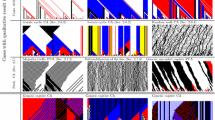Abstract
We study limit evolutions of cellular automata (CA) both theoretically and experimentally. We show that either all orbits enter the limit set after less than a finitely bounded number of states, or almost all orbits never enter the limit set. We link this result with a classification of CAs according to their limit behavior due to Čulik et al.: in the first case, the considered CA belongs to class 1 while in the second case, it belongs to class 2. By experiments, we try to measure the convergence speed of orbits to their accumulation points. We compute the maximum number of nested growing segments in a space-time diagram representing a finite portion of an orbit. We observe that, in the average case, this criterion depends only on the CA and not on the configuration. We also observe two kinds of CA wrt. our criterion which correspond to the intuitive notions of chaos and regularity. We do further experiments to explain the fact that the proportion of chaotic diagrams grows with the number of states of the considered CA.
This work was partially supported by the Esprit Basic Research Action “Algebraic and Syntactical Methods In Computer Science” and by the PRC “Mathématique et Informatique”.
Preview
Unable to display preview. Download preview PDF.
Similar content being viewed by others
References
S. Amoroso and Y.N. Patt. Decision procedures for surjectivity and injectivity of parallel maps for tesselation structures. J. Comp. Syst. Sci., 6:448–464, 1972.
K. Čulik, Y. Pachl, and S. Yu. On the limit sets of cellular automata. SIAM J. Comput., 18:831–842, 1989.
J. Kari. Rice's theorem for the limit set of cellular automata. Theoretical Computer Science, 127(2):229–254, 1994.
A. Maruoka and M. Kimura. Conditions for injectivity of global maps for tessallation automata. Information and Control, 32:158–162, 1976.
E.F. Moore. Machine models of self-reproduction. Proc. Symp. Apl. Math., 14:13–33, 1962.
J. Myhill. The converse to Moore's garden-of-eden theorem. Proc. Am. Math. Soc., 14:685–686, 1963.
D. Richardson. Tesselations with local transformations. Journal of Computer and System Sciences, 6:373–388, 1972.
S. Wolfram. Universality and complexity in cellular automata. In T. Toffoli D. Farmer and S. Wolfram, editors, Cellular Automata, pages 1–36. North-Holland, 1983.
S. Wolfram. Twenty problems in the theory of cellular automata. Physica Scripta, T9:170–183, 1985.
Author information
Authors and Affiliations
Editor information
Rights and permissions
Copyright information
© 1995 Springer-Verlag Berlin Heidelberg
About this paper
Cite this paper
Durand, B., Mazoyer, J. (1995). Growing patterns in 1D cellular automata. In: Reichel, H. (eds) Fundamentals of Computation Theory. FCT 1995. Lecture Notes in Computer Science, vol 965. Springer, Berlin, Heidelberg. https://doi.org/10.1007/3-540-60249-6_53
Download citation
DOI: https://doi.org/10.1007/3-540-60249-6_53
Published:
Publisher Name: Springer, Berlin, Heidelberg
Print ISBN: 978-3-540-60249-1
Online ISBN: 978-3-540-44770-2
eBook Packages: Springer Book Archive




